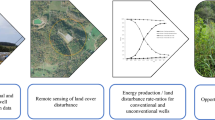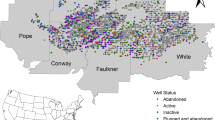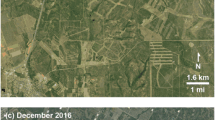Abstract
Unconventional oil and gas (UOG) wells from the Marcellus and Utica shale plays have expanded greatly across the Appalachian region of the United States (US) since the early 2000s. This region is now the single largest natural gas producing area of the US. The local and regional impacts of this industry on the landscape make it critical to understand for future planning efforts. This study investigated land cover change associated with over 21,000 unconventional wells representing 4,240 well pads permitted from 2007 to 2017 in Pennsylvania, West Virginia, and Ohio. The goal was to characterize UOG disturbance to document development patterns and extents in the region. Supervised classification was used to map land use and land-cover changes within a 25-ha buffer of well pads identified in the region. On average, disturbance related to unconventional development impacted 6.2 ha in Pennsylvania, 4.7 ha in Ohio and 4.4 ha in West Virginia and 5.6 ha over the region. Forest and grassland were found to be the most impacted cover types, with increases in impervious surface areas being a significant contributor to land-use classification change. These conversions can contribute to increased forest fragmentation and edge, which can in turn adversely impact biodiversity indicators at the regional level. Additionally, increases in impervious surface in small headwater watersheds can lead to increased sediment and runoff loads in receiving streams. Local and regional land use planning should be implemented during the well pad permit review process to help minimize environmental impacts over larger geographic scales.





Similar content being viewed by others
References
Abrahams LS, Griffin WM, Matthews HS (2015) Assessment of policies to reduce core forest fragmentation from Marcellus shale development in Pennsylvania. Ecol Indic 52:153–160. https://doi.org/10.1016/j.ecolind.2014.11.031
Aitchison, J (1986) The Statistical Analysis of Compositional Data. Chapman & Hall, New York, 416 pp
Brittingham MC, Maloney KO, Farag AM, Harper DD, Bowen ZH (2014) Ecological risks of shale oil and gas development to wildlife, aquatic resources and their habitats. Environ Sci Technol 48:11034–11047. https://doi.org/10.1021/es5020482
Costa D, Jesus J, Branco D, Danko A, Fiúza A (2017) Extensive review of shale gas environmental impacts from scientific literature (2010–2015). Environ Sci Pollut Res 24(17):14579–14594. https://doi.org/10.1007/s11356-017-8970-0
Donnelly S, Cobbinah Wilson I, Oduro Appiah J (2017) Comparing land change from shale gas infrastructure development in neighboring Utica and Marcellus regions, 2006–2015. J Land Use Sci 12:338–350. https://doi.org/10.1080/1747423X.2017.1331274
Drohan PJ, Brittingham M (2012) Topographic and Soil Constraints to Shale-Gas Development in the Northcentral Appalachians. Soil Sci Soc Am J 76:1696–1706. https://doi.org/10.2136/sssaj2012.0087
Drohan PJ, Brittingham M, Bishop J, Yoder K (2012) Early Trends in Landcover Change and Forest Fragmentation Due to Shale-Gas Development in Pennsylvania: A Potential Outcome for the Northcentral Appalachians. Environ Manag 49:1061–1075. https://doi.org/10.1007/s00267-012-9841-6
Entrekin S, Evans-White M, Johnson B, Hagenbuch E (2011) Rapid expansion of natural gas development poses a threat to surface waters. Front Ecol Environ 9:503–511. https://doi.org/10.1890/110053
Esri (2019) ArcGIS ArcMap Version 10.6 and Spatial Analyst Extension. Environmental Systems Research Institute, Redlands, CA
Evans JS, Kiesecker JM (2014) Shale gas, wind and water: Assessing the potential cumulative impacts of energy development on ecosystem services within the Marcellus play. PLoS ONE 9:1–9. https://doi.org/10.1371/journal.pone.0089210
Farwell LS, Wood PB, Sheehan J, George GA (2016) Shale gas development effects on the songbird community in a central Appalachian forest. Biol Conserv 201:78–91. https://doi.org/10.1016/j.biocon.2016.06.019
Farwell LS, Wood PB, Dettmers R, Brittingham MC (2020) Threshold responses of songbirds to forest loss and fragmentation across the Marcellus-Utica shale gas region of central Appalachia, USA. Landsc Ecol 35:1353–1370. https://doi.org/10.1007/s10980-020-01019-3
Grushecky ST, Zinkhan FC, Strager MP, Carr T (2022) Energy production and well site disturbance from conventional and unconventional natural gas development in West Virginia. Energ. Ecol. Environ (2022):1–11 https://doi.org/10.1007/s40974-022-00246-5
Hastings K, Heller LR, Stephenson EF (2017) Fracking and labor market conditions: A comparison of Pennsylvania and New York Border counties. East Econ J 43:649–659. https://doi.org/10.1057/eej.2015.47
Izadi G, Junca JP, Cade R, Rowan T (2014) Multidisciplinary study of hydraulic fracturing in the Marcellus shale. In 48th US Rock Mechanics/Geomechanics Symposium. OnePetro
Jantz CA, Kubach HK, Ward JR, Wiley S, Heston D (2014) Assessing land use changes due to natural gas drilling operations in the Marcellus shale in Bradford County, PA. Geogr Bull 55:18–35
Johnson N, Gagnolet R, Ralls E, Zimmerman B, Eichelberger C, Tracey G, Kreitler S, Orndorf J, Tomlinson S, Bearer S, Sargent S (2010) Pennsylvania Energy Impacts Assessment. Report 1: Marcellus Shale Natural Gas and Wind. The Nat Conserv. https://www.nature.org/media/pa/tnc_energy_analysis.pdf. Accessed 27 Oct 2021
Kargbo DM, Wilhelm RG, Campbell DJ (2010) Natural gas plays in the Marcellus shale: Challenges and potential opportunities. Environ Sci Technol 44:5679–5684. https://doi.org/10.1021/es903811p
Langlois LA, Drohan PJ, Brittingham MC (2017) Linear infrastructure drives habitat conversion and forest fragmentation associated with Marcellus shale gas development in a forested landscape. J Environ Manag 197:167–176. https://doi.org/10.1016/j.jenvman.2017.03.045
Leff, E (2015) Final Supplemental Generic Environmental Impact Statement on the Oil, Gas and Solution Mining Regulatory Program. Regulatory Program for Horizontal Drilling and High-Volume Hydraulic Fracturing to Develop the Marcellus Shale and Other Low-Permeability Gas Reservoirs. NY Department of Environmental Conservation. https://www.dec.ny.gov/energy/75370.html. Accessed 27 Oct 2021
Lillesand T, Kiefer R, Chipmpan J (2015) Remote sensing and image interpretation, 7th edn. John Wiley and Sons. New York, p 736
Litvak A (2018) These days, oil and gas companies are super-sizing their well pads. Pittsburgh Post-Gazette. https://www.post-gazette.com/business/powersource/2018/01/15/These-days-oil-and-gas-companies-are-super-sizing-their-well-pads/stories/201801140023. Accessed 27 October 2021
Liu Y (2021) Remote Sensing of Forest Structural Changes Due to the Recent Boom of Unconventional Shale Gas Extraction Activities in Appalachian Ohio. Remote Sens 13:1453. https://doi.org/10.3390/rs13081453
Ogoke V, Schauerte L, Bouchard G, Inglehart S (2014) Simultaneous operations in multi-well pad: a cost effective way of drilling multi wells pad and deliver 8 Fracs a day. Proc SPE Annu Techn Conf Exhib 3(2001):2234–2244
Olmstead SM, Muehlenbachs LA, Shih JS, Chu Z, Krupnick AJ (2013) Shale gas development impacts on surface water quality in Pennsylvania. Proc Natl Acad Sci USA 110:4962–4967. https://doi.org/10.1073/pnas.1213871110
Olofsson P, Foody GM, Herold M, Stehman SV, Woodcock CE, Wulder MA (2014) Good practices for estimating area and assessing accuracy of land change. Remote Sens Environ 148:42–57. https://doi.org/10.1016/j.rse.2014.02.015
Olofsson P, Foody GM, Stehman SV, Woodcock CE (2013) Making better use of accuracy data in land change studies: Estimating accuracy and area and quantifying uncertainty using stratified estimation. Remote Sens Environ 129:122–131. https://doi.org/10.1016/j.rse.2014.02.015
Pierre JP, Wolaver BD, Labay BJ, LaDuc TJ, Duran CM, Ryberg WA, Hibbitts TJ, Andrews JR (2018) Comparison of recent oil and gas, wind energy, and other anthropogenic landscape alteration factors in Texas through 2014. Environ Manag 61:805–818. https://doi.org/10.1007/s00267-018-1000-2
Popova O (2017a) Marcellus Shale Play: Geology Review. U.S. Energy Information Administration. https://www.eia.gov/maps/pdf/MarcellusPlayUpdate_Jan2017.pdf. Accessed 27 Oct 2021
Popova O (2017b) Utica Shale Play: Geology Review. U.S. Energy Information Administration. https://www.eia.gov/maps/pdf/UticaShalePlayReport_April2017.pdf. Accessed 27 Oct 2021
Ramezan CA, Warner TA, Maxwell AE (2019) Evaluation of sampling and cross-validation tuning strategies for regional-scale machine learning classification. Remote Sens 11:185. https://doi.org/10.3390/rs11020185
Ritters KH, Wickham JD, O’Neill RV, Jones KB, Smith ER, Coulston JW, Smith JH (2002) Fragmentation of continental United States forests. Ecosyst 5:815–822. https://doi.org/10.1007/s10021-002-0209-2
Sangaramoorthy T (2018) Maryland is not for Shale: Scientific and public anxieties of predicting health impacts of fracking. Extr Ind Soc 6:463–470. https://doi.org/10.1016/j.exis.2018.11.003
Scanlon B, Reedy R, Male F, Walsh M (2017) Water issues related to transitioning from conventional to unconventional oil production in the Permian Basin. Environ Sci Technol 51(18):10903–10912. https://doi.org/10.1021/acs.est.7b02185
Slonecker ET, Milheim LE (2015) Landscape disturbance from unconventional and conventional oil and gas development in the Marcellus Shale region of Pennsylvania, USA. Environ 2:200–220. https://doi.org/10.3390/environments2020200
Slonecker ET, Milheim LE, Roig-Silva CM, Fisher GB (2012a) Landscape consequences of natural gas extraction in Greene and Tioga Counties, Pennsylvania, 2004–2010. US Department of the Interior, US Geological Survey Open File Report 2012-1220, p 32. https://pubs.usgs.gov/of/2012/1220/ofr2012-1220.pdf. Accessed 27 Oct 2021
Slonecker ET, Milheim LE, Roig-Silva CM, Malizia AR, Marr DA, Fisher GB (2012b) Landscape consequences of natural gas extraction in Bradford and Washington Counties, Pennsylvania, 2004–2010. US Department of the Interior, US Geological Survey Open File Report 2012-1154, p 36. https://pubs.usgs.gov/of/2012/1154/of2012-1154.pdf. Accessed 27 Oct 2021
U.S. Department of Energy (USDOE) (2020) The Appalachian Energy and Petrochemical Renaissance. An Examination of Economic Progress and Opportunities. https://www.energy.gov/sites/prod/files/2020/06/f76/Appalachian%20Energy%20and%20Petrochemical%20Report_063020_v3.pdf. Accessed 27 Oct 2021
U.S. Energy Information Administration (US EIA) (2016a) Maps: Oil and Gas Exploration, Resources, and Production. Appalachian Basin Map Data. https://www.eia.gov/maps/maps.htm. Accessed 25 Oct 2021
U.S. Energy Information Administration (US EIA) (2016b) Trends in U.S. Oil and Natural Gas Upstream Costs. https://www.eia.gov/analysis/studies/drilling/pdf/upstream.pdf. Accessed 2 June 2022
U.S. Energy Information Administration (US EIA) (2019) Dec 2019 Monthly Energy Review. U.S. Energy Information Administration. https://doi.org/10.1044/leader.ppl.24062019.28
U.S. Energy Information Administration (US EIA) (2020) Natural gas explained. https://www.eia.gov/energyexplained/natural-gas/. Accessed 27 Oct 2021
U.S. Energy Information Administration (US EIA) (2021) Where our natural gas comes from. https://www.eia.gov/energyexplained/natural-gas/where-our-natural-gas-comes-from.php. Accessed 08 January 2022
U.S. Fish and Wildlife Service (US FWS) (2020) Range-Wide Indiana Bat Survey Guidelines. Midwest Region Endangered Species, Bloomington, MN. https://www.fws.gov/midwest/endangered/mammals/inba/inbasummersurveyguidance.html. Accessed 27 Oct 2021
Villemey A, Jeusset A, Vargac M, Bertheau Y, Coulon A, Touroult J, Vanpeene S, Castagneryrol B, Jactel H, Witte I, Denuaud N, Flamerie De Lachapelle F, Jaslier E, Roy V, Guinard E, Le Mitouard E, Rauel V, Sordello R (2018) Can linear transportation infrastructure verges constitute a habitat and/or a corridor for insects in temperate landscapes? A systematic review. Environ Evid 7:1–33
West Virginia Department of Environmental Protection (WVDEP) (2012) West Virginia Erosion and Sediment Control Field Manual, Charleston, WV. https://dep.wv.gov/oil-and-gas/Documents/Erosion%20Manual%2004.pdf. Accessed 27 Oct 2021
Young J, Maloney KO, Slonecker ET, Milheim LE, Siripoonsup D (2018) Canopy volume removal from oil and gas development activity in the upper Susquehanna River basin in Pennsylvania and New York (USA): An assessment using lidar data. J Environ Manag 222:66–75
Acknowledgements
This work was supported by the United States Department of Agriculture National Institute of Food and Agriculture, Hatch project accession number 1015648 and McIntire Stennis project number WVA00806, and the West Virginia Agricultural and Forestry Experiment Station.
Author contributions
STG, KJH, MPS, and JW contributed to original study design. Data collection and GIS analyses provided by Harris and Mesa. First draft of manuscript based on MS thesis by Harris. Manuscript developed by Grushecky and reviewed and edited by all authors.
Funding
This material is based upon work that is supported by the National Institute of Food and Agriculture, U.S. Department of Agriculture, McIntire Stennis at West Virginia University.
Author information
Authors and Affiliations
Corresponding author
Ethics declarations
Conflict of interest
The authors declare no competing interests.
Additional information
Publisher’s note Springer Nature remains neutral with regard to jurisdictional claims in published maps and institutional affiliations.
Rights and permissions
Springer Nature or its licensor holds exclusive rights to this article under a publishing agreement with the author(s) or other rightsholder(s); author self-archiving of the accepted manuscript version of this article is solely governed by the terms of such publishing agreement and applicable law.
About this article
Cite this article
Grushecky, S.T., Harris, K.J., Strager, M.P. et al. Land Cover Change Associated with Unconventional Oil and Gas Development in the Appalachian Region. Environmental Management 70, 869–880 (2022). https://doi.org/10.1007/s00267-022-01702-y
Received:
Accepted:
Published:
Issue Date:
DOI: https://doi.org/10.1007/s00267-022-01702-y




